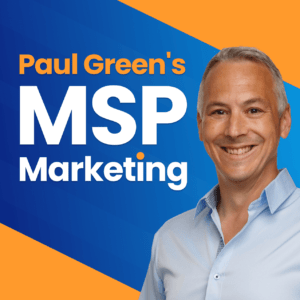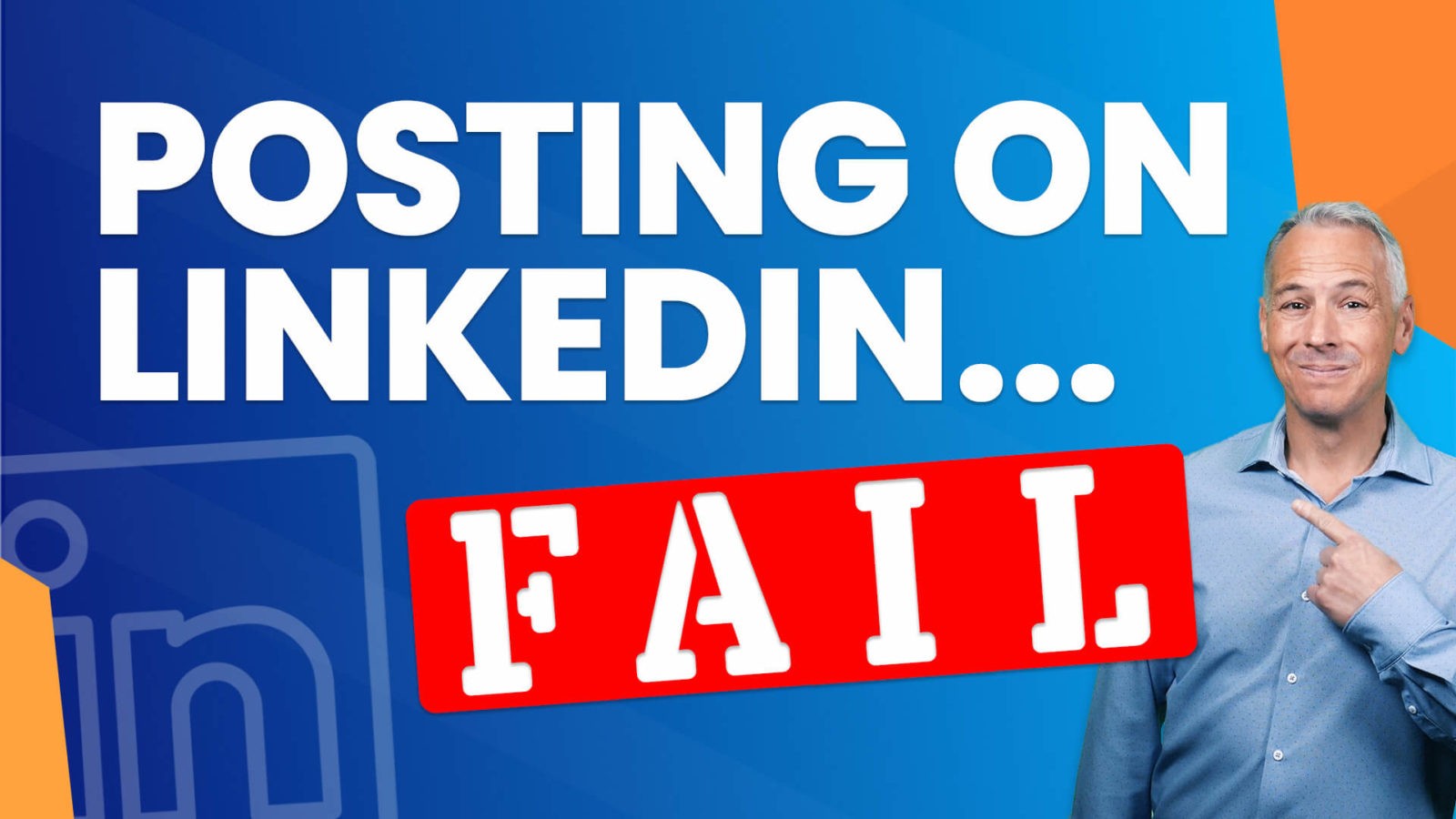
The podcast powered by the MSP Marketing Edge
Welcome to Episode 280 of the MSP Marketing Podcast with me, Paul Green. This week…
- MSPs: You can (almost) never post too much content: Let’s dig into the suggested rules about the frequency of posting content for MSPs and how to do it in a way that you feel comfortable with.
- The best MSP marketing tactic I learned at an event: It was listening to talks from two marketing legends that inspired this new MSP marketing tactic, and I believe it’s one that you should start using.
- Why your MSP must be all over your Google Business Profile: You want more traffic to your MSP’s website and you’ve maybe even looked at how to improve your SEO, but did you know there’s a solid basic that you must get right first?
- Paul’s Personal Peer Group: Have you ever wondered what is being written about your business online? Find out how you can track this in one simple, free step.
MSPs: You can (almost) never post too much content
If LinkedIn is like an MSP goldmine, is there a risk you could over mine it? It’s a valid concern. So many MSPs are worried about this. When you’re looking for new clients and you know that you’ve got access to a gleaming rich source of them, whether that’s on LinkedIn or even in your email list, is there a risk you could annoy them by trying to mine them too often, by flooding them with content and messages?
Let’s dig into the suggested rules about the frequency of posting content, how to do it in a way that you feel comfortable with, and the big opportunity for MSPs that are mining for new clients in 2025.
I’m sure that as a technology expert, you hear the same questions all the time from your clients. In fact, could you list the top three things that people are most likely to ask you? Well, this is my experience as well, and almost every single day of the week I’m talking to a new MSP from somewhere. It could just be a chat on LinkedIn or maybe I’m doing a webinar and answering a question or whatever. And over the years, I’ve noticed that the questions I get asked are often very similar.
People ask like, is LinkedIn still valid? They ask about their websites. They ask about whether or not they should be hiring marketing agencies and salespeople. One of the most common questions that I get is about content. How should content be posted and at what point does your content become overwhelming? Actually, the way that question is normally asked to me is by someone saying that they don’t want to send out more than one email a month or post no more than once a week on LinkedIn, because they’re scared that people will get sick of their content and sick of seeing stuff from them.
Well, let me tell you the answer that I always give them.
I believe as an MSP, you can almost never post too much content.
It just couldn’t happen. Because marketing is not your superpower and to a certain extent it’s a bit of a distress activity for you, right? So you’re never going to do as much marketing as, for example, I might do. You’re simply not going to tackle it with the level of aggression that’s ultimately going to frustrate the people that that content is aimed at.

The cadence that I suggest for most MSPs when it comes to posting content is: to post on social media daily, send an educational email weekly and send something in the post, so ship it to them in the mail no more than once a month. That’s a great cadence and it’s not too much at all. Let me explain why. You might look at all of that and think, well, Paul, that’s an overwhelming amount of content to send out, nevermind the fact that you’ve got to originate it all in the first place. It’s just a huge amount of overwhelm, for someone who has to consume all of that content. But here’s the reality… the only person on the whole planet who’s consuming all of the content that you create is you and your marketing team. The people that you are targeting, they’re only seeing and perceiving a tiny proportion of it.
If you take, for example, posting social media content every day, the vast majority of your connections and followers are simply not going to see it every day. They might see one, maybe two things a week. If you look at educational emails, you can assume that the average person only opens one in four of your emails. So by sending them an email once a week, they’re actually reading one of your emails once a month. So therefore, if you only send them an email once a month, they’re only seeing one of your emails every four months, which is just not enough.
Do you see where I’m going with this? Your lack of marketing aggression and the fact that people simply do not consume everything that you send out, means that you have to send out more content more often as this is the best way to get in front of people. They are doing the filtering for you. Remember, the whole goal with your marketing is to get the right message in front of the right person at the right time. And a good cadence like I’ve just suggested there, will make it dramatically easier for you to do that.
Some say that in wanting to make more money for your MSP, there are no new ideas. Well, there aren’t until you discovered this one. Because you know that one of the most important ways to grow is by building a sales engine, powered by marketing and new clients. And this insanely smart new idea is like a miracle engine component that no one knew existed. So take this incredible marketing tactic inspired by something I heard at ScaleCon, and implement it in your MSP to help you win loads of lovely new clients.
Back in October last year, I was speaking at the inaugural three day ScaleCon 24 in Las Vegas. What an event that was. I’ve read so much of the feedback about it online and 97.4% of that is highly positive. In fact, I’ve agreed to speak again at ScaleCon 25, and I know lots of MSPs who’ve already bought their tickets.
Anyway, back at the last one, I was honoured to deliver the marketing keynote at the end of day one. And I showed a few hundred MSPs how doing just 90 minutes of marketing every weekday builds up over years into creating an epic lifestyle. I also met tons of lovely people, including many members of my MSP Marketing Edge service and some industry giants as well. And many of those people are Zoom friends that I met in real life for the first time.
It was listening to talks from two marketing legends that inspired the new MSP marketing tactic that I want to tell you about, because I believe it’s one that you should start using.
So first off, Nate Freedman of MSP Sites spoke, and for years I’ve been saying that the best CTA (call to action) on your website is to show your live calendar and encourage leads to book a 15 minute video call with you. Nate agrees with me on this and in his talk he said that someone who’s ready to book a call will be motivated enough to fill in a short data capture form first, which makes perfect sense. A lead who’s ready to talk is unlikely to be put off by giving a little data just to access your live calendar. So there we’ve got data capture leading into live calendar.

And then Kevin Clune of MSP Growth Hacks said something in his talk that added another dimension to this. He discussed the long known fact that every extra piece of data you ask for during data capture lowers your response rate. So instead of asking for their full name, their company name, their email, their address, their website, their physical address, their phone number… that’s a lot of data, instead you just ask for their email address. Bingo. You then have zero friction on the data capture form and more conversions. Here’s the really smart bit, then you use something called data enrichment to find the rest of their details. This is where you use a service to automatically find their data and add it into your CRM. Here’s an example, but not a recommendation. It’s called Clay. Go and have a look at that and you can find alternatives to you as well.
Now, if you put Nate and Kevin’s ideas together, you get this flow, you get email address only data capture, leading into live calendar, leading into data enrichment – very smart and very efficient. And that was just one of dozens of smart strategies and tactics that I picked up from this event. So tell me, if you were at ScaleCon last year, what was the smartest thing that you heard?
Why your MSP must be all over your Google Business Profile

Featured guest: Andrew Laws founded the yeseo.io SEO Agency and has been battling SEO for over 25 years.
When he’s not in the office helping clients grow, he can be found in the studio or on stage, making very loud noises.
Andrew loves to talk about mindset, personal growth, business development, neurodiversity and odd music.
So you want more traffic to your MSP’s website and you’ve maybe even looked at how to improve your SEO, your search engine optimization. But did you know there’s a solid basic that you must get right first? It’s something really easy that you can do yourself in just an hour or so. My special guest today is an expert at exactly this subject. He’ll tell you what this is, why you must get it right, and how getting it right can drive a lot more traffic and ultimately new clients into your business.
Hi, I’m Andrew Laws. I am the senior owner of white hair at Yeseo and I help businesses grow.
That’s got to be one of those names that you sit there and you’re thinking, right, we need a new business name. We’re going to do SEO. Got a positive attitude. I got it, I got it. Let’s call it Yeseo, it’s a brilliant company name. Thank you so much for joining me on the show, Andrew. And we are going to talk today primarily about Google Business Profile, why every MSP needs to be on top of that, the mistakes that you’re going to make, why you must make those mistakes and how it affects your overall SEO. And before we get into that, just tell us a bit about you, Andrew. So you’ve got this agency, you’ve clearly been doing marketing a very long time. How did you get into it and get into the position of owning the business you’ve got now?
I got into this by being an IT consultant initially, and this is back in the days of building web servers and “coloing” them, so you’re driving them off to mysterious cupboards on the internet all over the place. I started building websites and realised no one’s going to see these websites. And then AltaVista and HotBot and all these mysterious search engines came along. And I thought, do you know what? If my websites get found first, I’ll probably do Okay. So to test it, I launched a badge making company. I only had the budget to buy the badge making machine, but I had that an SEO. And that company, which I haven’t owned for years, is still number one in the country 25 years later. And I think that’s quite exciting.
That’s pretty exciting. And it’s the ultimate test, and I guess that’s the kind of thing you could do 25 years ago when there wasn’t a lot of competition. But obviously today there is an enormous amount more competition. And in fact, one of the biggest marketing challenges for MSPs is how do you beat all of the other MSPs in this town when actually you’ve got one or two players investing in SEO, you’ve got a couple of other players investing in pay-per-click and everyone else seems to be dominant.
Let’s come back to Google and Google in particular, why should we bother with Google? Because you’re talking about the past days and Google has been the dominant search engine and still continues to be these days, but the US government’s trying to break it apart and ChatGPT is trying to steal its breakfast, and voice search I mean voice search, it’s been around for years, but it seems like today it’s better than it used to be. Is it still worth us bothering with Google?
It absolutely is. When it comes down to it, if you don’t tell Google about your business, Google will just make stuff up and the danger is they’re going to tell your potential clients about those things. I won’t go into great depth, but everything that I’m going to talk about today also fits for AI. So I won’t go into too much depth on that now, but good practice with Google equals good practice with AI and getting found by voice search and the other things you mentioned.
Yeah, which I think are going to be more important things we’re going to talk about in the years to come. So let’s do the basics on Google Business Profile. Can we even go back a step and explain what is Google Business Profile and where’s it come from and why is it so important right now?
Well, it’s come from Google’s obsession with becoming the most dominant thing on the earth, but you will have seen this many times yourself, it comes up in two places. If you search for something on Google, sometimes a little map section pops up and you’ll have a little map hopefully of where roughly where in the world you are. Then it’ll list three, maybe five businesses and you can see how many reviews they’ve got and things like that. That information is taken from Google Business Profile. You might also have seen it on Google Maps, even just on your phone, if you’re searching for something and you see little flags or little pointers showing you where businesses are, that all comes from Google Business Profile.
And so as an MSP, you can’t assume that Google knows that you exist and that you’re there even if you’ve been around for a number of years in your location, you have to claim the profile and you have to go and do some work to make sure Google has the correct information.
You absolutely do. And the good news is that it’s not a lot of work. The important information to remember here though is Google will make it up. I’m a guitarist, so I spend more money than I should on effects pedals, little boxes that make silly noises. And I had one delivered to an office where I used to be located. I was like, oh my goodness. So I looked up who was in the building now, and it said the building name, it said the company name. And then there was this red text that said permanently closed. And I thought, oh no, I’ve lost my pedal. How am I going to explain that to my partner? It’s going to be hard enough to explain why I spent so much anyway. So I drove out there expecting to find an abandoned building and there was a thriving business in there. And I went in and I said, first of all, thank you for taking my parcel. And I said, do you know Google’s telling people you’re permanently closed? And they just shrugged. And I find that alarming because any of the MSP owners watching this or listening to it will have spent money marketing their business already telling people about the business or just growing the business by being an excellent MSP provider.
It crushes me to think that Google might be telling your audience that you’ve gone out of business – and that’s just Google assuming it of course.
It does make me laugh, about half an hour away from my home there is a massive empty site that used to be a brickworks, I think, and Universal, as in the theme parks predominantly in the US have bought that land. And they’re talking about building Europe’s biggest theme park there. And what’s funny is a couple of weeks ago it turned up on Google as a Google business listing as permanently closed. And we’re talking a site that’s a brown field site, there’s nothing there. And that did amuse people locally, but it just goes to show that there’s no human at Google doing this. I guess it’s just the machine making assumptions. Oh, no one’s claimed this. We haven’t heard anything from this for a while, and we’re going to close this down.
Okay, so let’s recommend something right now for all MSPs, unless you are driving right now, grab your mobile phone or get on your PC and just Google your own business and just double check. And we are looking at the right hand side, aren’t we, Andrew?
It’s often on the right hand side, if you put in the exact name of your business, it’s usually going to come up on the right hand side and there’s going to be some information there and you need to check that’s correct. This can come down to your office hours or when you’re actually available. I mean, there’s MSP owners I guess are technically available all the time. Is that fair or am I going to upset people?
Technically available all the time, but you’ve heard of sleep of course, which is kind of important. So most people have office hours in some way, but no, you’re absolutely right and things like those are details that you perhaps want to control yourself. If you have a listing on Google, but you haven’t yet claimed it, so you can see that your business is there and there’s some information which may or not be correct, but you don’t have a way of doing that. How do you actually claim that business in the first place?
It’s delightfully easy, but people think it’s quite difficult so you might find that your competitors, your other MSP owners will be scared of this. So I’m going to make it very, very simple. Google your name as Paul just said, and if you look very closely in that box of information, there’ll be a little bit of text that says something like, Own this business? Claim it now. I say like this text because it does change, but it’ll be clear. If you can’t find that, the other easiest way to do it is just go to business.google.com, any browser, any computer, and when you get there, you’ll have the opportunity to claim your business. And it’s easy, I promise. It’s really easy.
And I know back in the day they used to do a thing where they would send a letter out to that physical address with a verification code. Are they still doing that in 2025?
Sometimes, but most of the time not. It’s a curious thing that they’ve stopped sending that postcard out. Usually they’ll ask you for a business number and it doesn’t matter if it’s a landline or a mobile number. And if you do that, they’ll ring your number straight away and there’ll be a very emotionless Google voice on the other end that’ll give you a number to put into the website. But it all happens instantly. It’s all while you’re there.
What we’re finding increasingly these days is MSP owners who have also set up other Google things, so maybe you’re using Gmail or Google Analytics or one of those, Google kind of goes, oh, actually we already know who you are and we didn’t know you were connected to this business. So now we have more trust in this business. And when Google trusts a business, those businesses higher up in search results. So yes, they do. Sometimes they ask people to make a video, but don’t let that worry you. No human’s ever going to see it.
That’s good. That’s good. I can’t imagine what kind of video would be of interest to Google, but I guess it’s just one of those verification videos that you get. So in terms of once you’ve claimed that profile, and for those MSPs that are already all over this and they’ve done this before, perhaps the crime they’re then committing is not going in and updating that regularly. Or you can do actual text updates. In fact, with our MSP marketing Edge service, we give our members some content to put into Google Business Profile every single week. There’s a video and some text they can put in, which obviously again comes up on the right hand side when someone looks at their business. And I don’t know whether it has an algorithmic benefit or not, but from a human point of view, it certainly shows that you’re active. So what would you suggest the average MSP does and what kind of cadence should they go in and check information and add updates?
At the very least, get the Google Business Profile app on your phone because that will give you prompts. And even if you are not necessarily really focused on digital marketing, because it can be a challenge unless you have somebody like Paul do it for you, if you’re not necessarily focused on it, they will prompt you. In terms of what the frequency should be, there isn’t a real carved in stone answer. I would say get to know your competitors, look what they’re doing, and then go one step better. Incidentally, you mentioned something there, we’re not going to talk in depth about SEO, but you mentioned, does it make any difference to post your new articles on your Google Business profile? We believe it absolutely does, because when you put a new article on a website, it can take Google a little while to figure out it’s there. If you put it in your Google Business Profile, it’s like ringing a bell at Google HQ and some little robot goes running to its desk and goes, Hey, look, this company’s got a new post, we’d better tell everyone about it. As a rule, you can assume with any Google Service, if you doff your cap to them and play their games, you’ll probably do well from it.
Yes, I like the sound of that. And you mentioned SEO, let’s just look at Google within part of your overall SEO strategy. So again, let’s take the average MSP that wants local business owners and managers within a certain geographical area, and increasingly those geographical areas are getting wider. But as an SEO expert, how important do you believe the Google Business Profile is as part of your overall SEO strategy?

It’s incredibly important, especially if you service a geographical area, because Google will look at the address that you’ve confirmed when you’ve signed up for Google Business Profile, and then they’ll look at the address on the bottom of your website. So those two things have to be exactly the same. Then Google goes out and looks at local directories like yell.com or Scoot or any of the many ones, and it starts to build a picture in Google’s mind of how important you are for a specific area.
So one of the things we recommend, which is quite an easy SEO win to help you appear more often, is create case studies about people you have helped in your area. Because Google sees the address on Google Business Profile, it sees the address on your website, and it sees the town name, where you’ve written a brilliant article about being the best MSP in the country means that you helped Jack’s Cafe in Brentwood do something cool. So I sort of ran out at the end there, but in answer, the easy answer is it’s very important.
Thank you, Andrew. You’ve delivered a ton of value there, and it all sounds like basic stuff, but often these are the basic building blocks that people skip over in the drive to do the new, exciting, shiny things. So please do as an MSP listening to this or watching this, please do jump on that and make sure you’ve ticked every box there. Andrew, tell us a little bit more what you do to help MSPs and how can we get in touch with you?
Put simply, we get MSPs more clients. We find the people who need your services, and we make sure they find you before they find your competitors. If you’d like to find out more about what we do, please have a look at yeseo.io. That’s YESEO.io, and you’ll see my face on there somewhere. Or you can look for me on LinkedIn, just do a search for Andrew Laws.
Paul’s Personal Peer Group
Jordan in Phoenix, understands that it’s important to promote his MSP but thinks if someone else were to do it, that would be so much more valuable. His question is: How do I know if someone’s written about my business?
Well, the simplest and most effective monitoring tool is powerful and free. And you know it already probably, it’s Google Alerts. Just set up alerts for your name and for your company name, and if you put them in speech marks that will avoid false positives.
For example, if your business is called Badger IT, you’ll get an alert every time the words “badger” or “IT” appear in a story, which is a lot. Whereas if you set up an alert for “Badger IT” in speech marks, you’ll only get the alert when it’s actually your business name.
And while you’re there, why not set up alerts for your competitors’ business names, just to keep track of what’s being said about them online. And by the way, they won’t know that you have done this.
Mentioned links
- This podcast is in conjunction with the MSP Marketing Edge, the world’s leading white label content marketing and growth training subscription.
- Join me in MSP Marketing Facebook group.
- Connect with me on LinkedIn.
- Connect with my guest, Andrew Laws on LinkedIn, and visit the yeseo.io website.
- Got a question about your MSP’s marketing? Submit one here for Paul’s Personal Peer Group.
